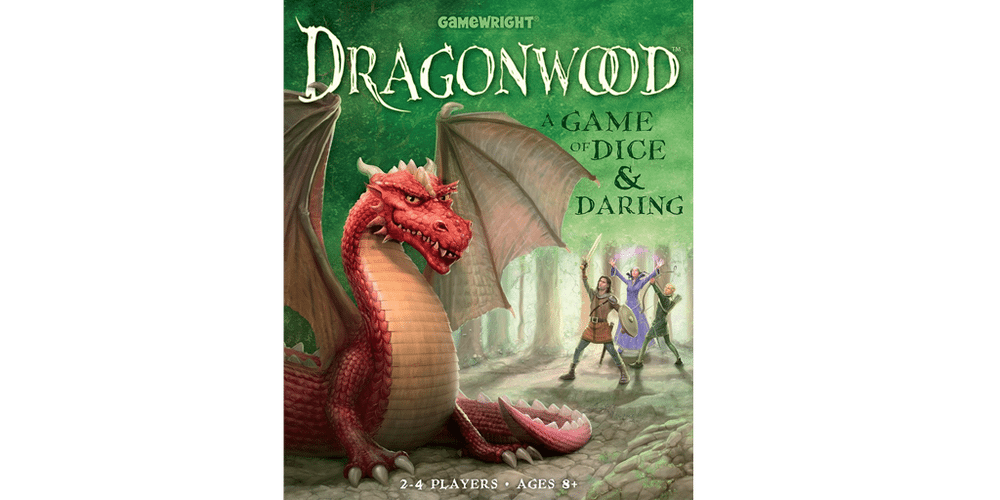What Is WILD: Serengeti?
WILD: Serengeti is a tabletop game set in Africa for 1-4 players, ages 14 and up, and takes about 45-120 minutes to play. Players take turn performing actions such as placing different types of animals on a map. They want to position these animals to match the requirements on scene cards in order to earn points. WILD: Serengeti has puzzle elements along with worker placement and set collection. It’s currently seeking funding on Kickstarter, with a pledge level of $52 for a copy of the game. WILD: Serengeti was designed by Gunho Kim and published by Bad Comet Games, with illustrations by Hani Chang and Sophia Kang.
New to Kickstarter? Check out our crowdfunding primer.
WILD: Serengeti Components
Note: My review is based on a prototype copy, so it is subject to change and may not reflect final component quality.
- 1 Map
- 1 Action Board
- 1 Rock of Ages
- 168 Scene Cards
- 12 Great Migration Cards
- 12 Specialist Cards
- 4 Player Aids
- 1 Rulebook
- 46 Coin Tokens
- 50 SFX Tokens
- 45 Food Tokens
- 8 Lock Tokens
- 4 Video Gallery Bars
- 1 First Player Marker
- 1 Round Marker
- 8 Player Markers (in 4 colors)
- 36 Animals (3 of each of 12 different animals)
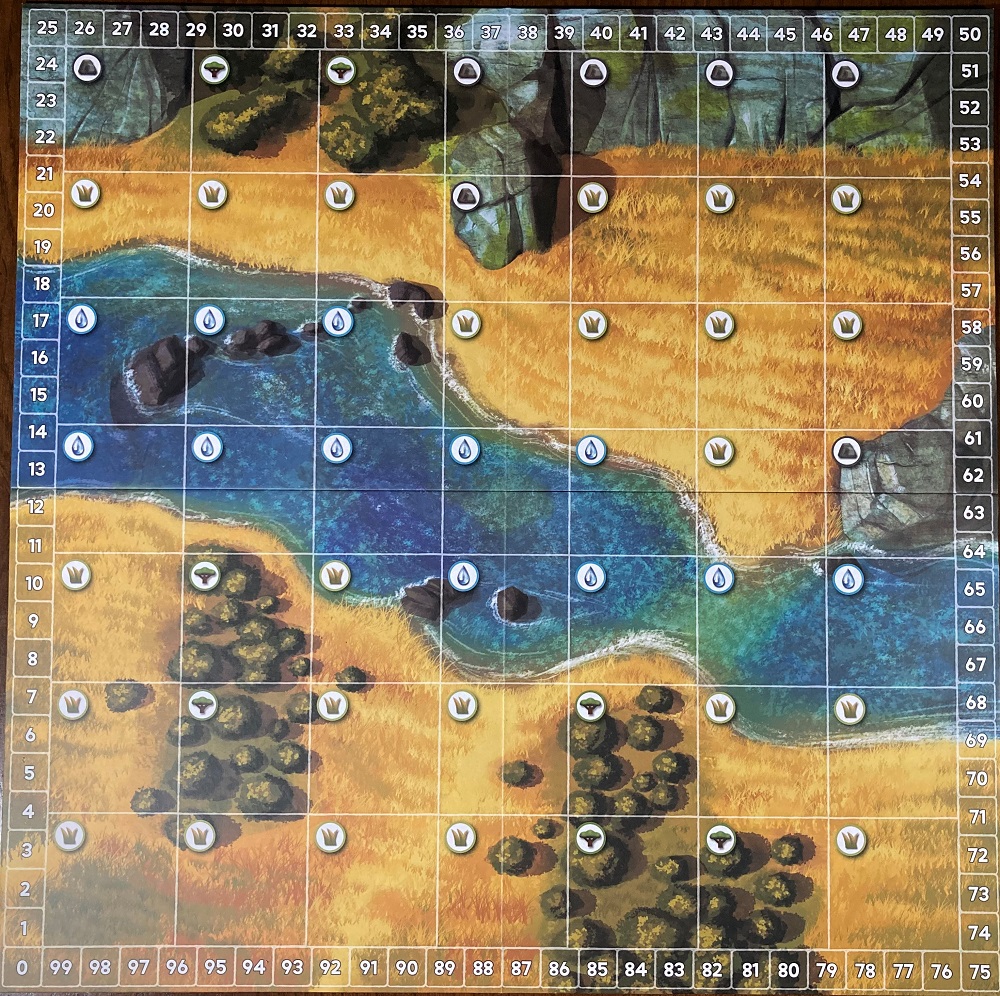
The map is divided into 49 spaces representing the Serengeti. Each space has an icon in the upper right corner showing the type of terrain. The four terrains are grasslands, water, woodlands, and rock. Some scene cards require an animal to be in one of these terrains. The numbers along the edge of the map form a point track where players can keep track of their current score.
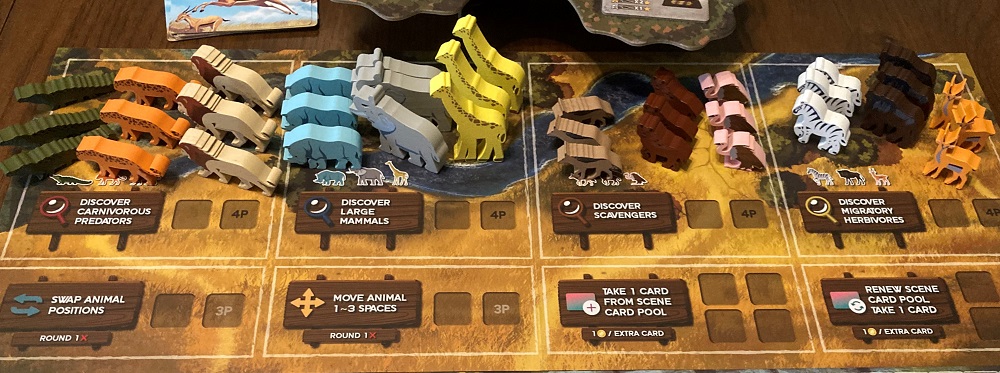
The action board is divided into 8 areas representing the basic actions players may take on their turn. Small spaces on each section are where players can place their player marker in order to take that action.
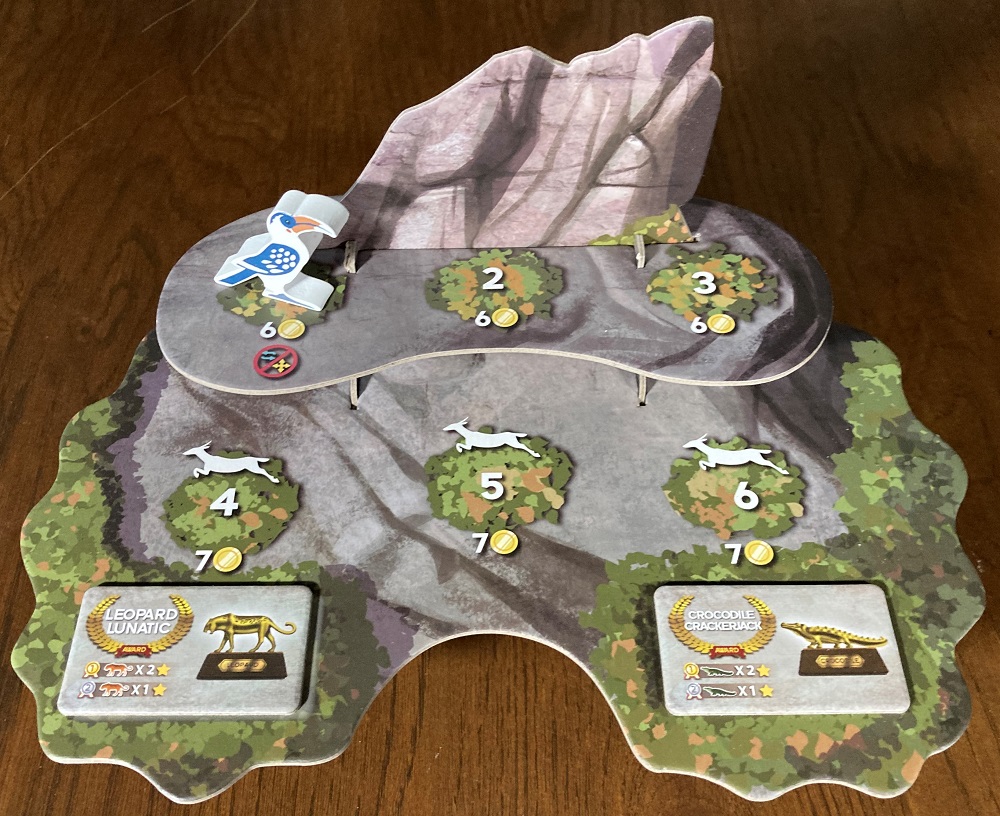
The Rock of Ages keeps track of the current round and informs players about steps to be taken during the round preparation phase. The award tiles are placed next to the 4th and 6th round spaces at the start of the game.
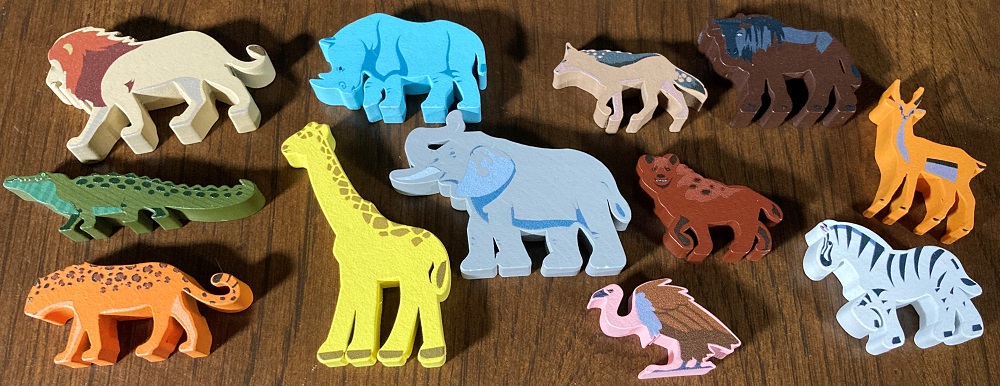
WILD: Serengeti includes 36 wooden animal meeples. There are three copies of each of the 12 types of animals including crocodiles, lions, cheetahs, rhinos, elephants, giraffes, hyenas, jackals, vultures, gazelle, zebras, and wildebeests. They start out on the action board and can be placed on the map by players as their actions. These animals are used by players to complete scene cards.
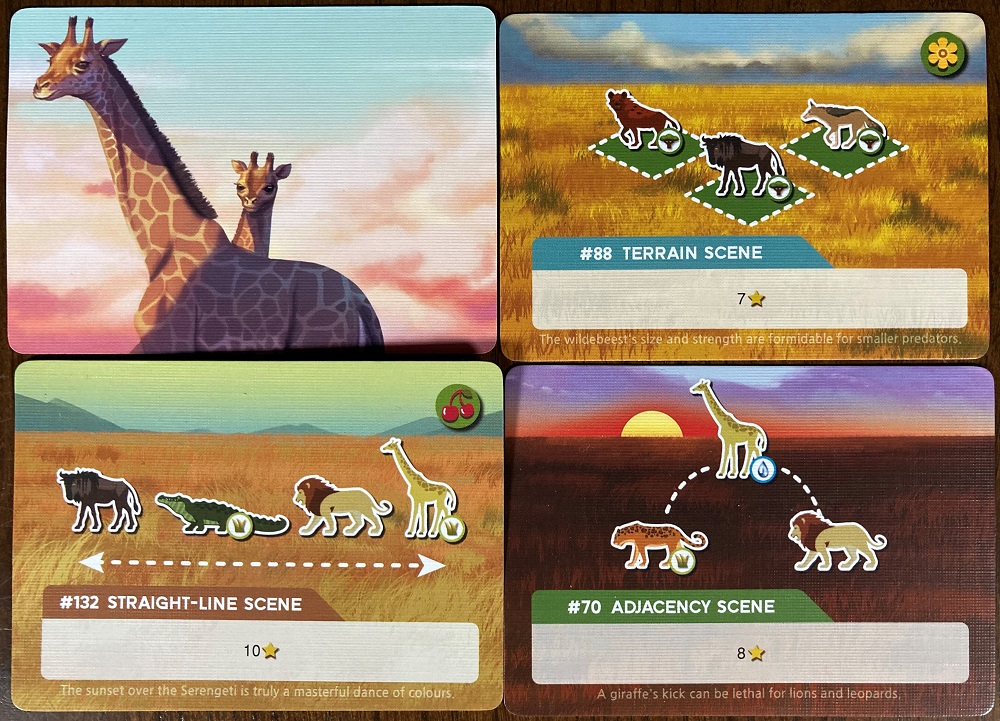
Scene cards represent tasks for players to complete. They show an arrangement of animals that the player must complete in order to collect the reward at the bottom of the card. Some scene cards are more difficult to complete than others, but that means they are also worth better rewards.
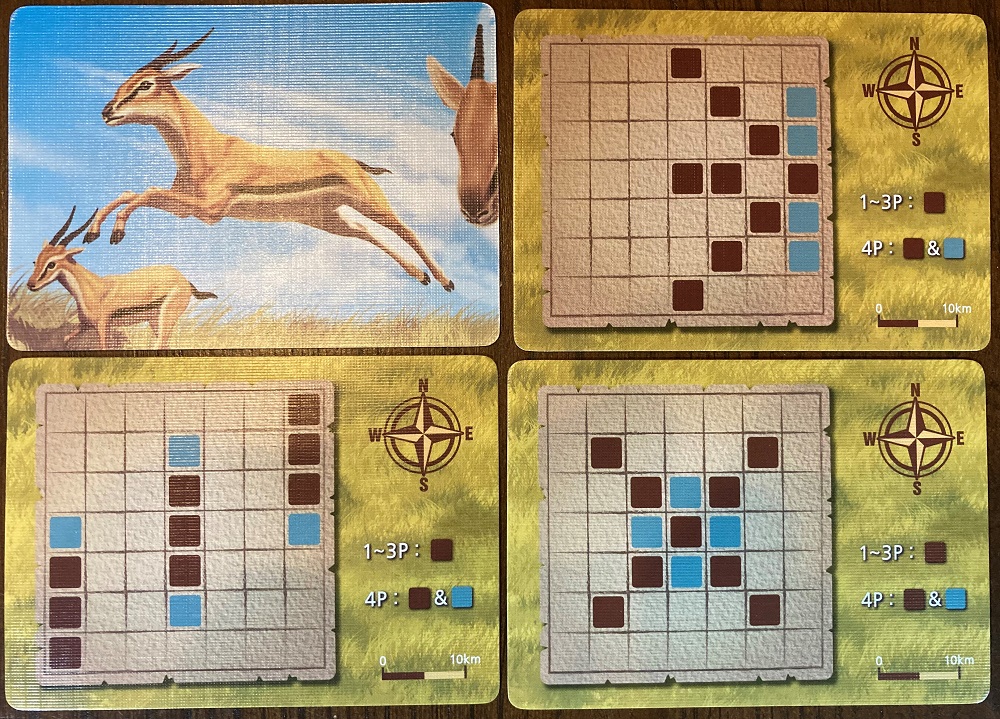
Great Migration cards are used during the round preparation phases prior to rounds 4-6. They show which animals are removed from the map due to migration.
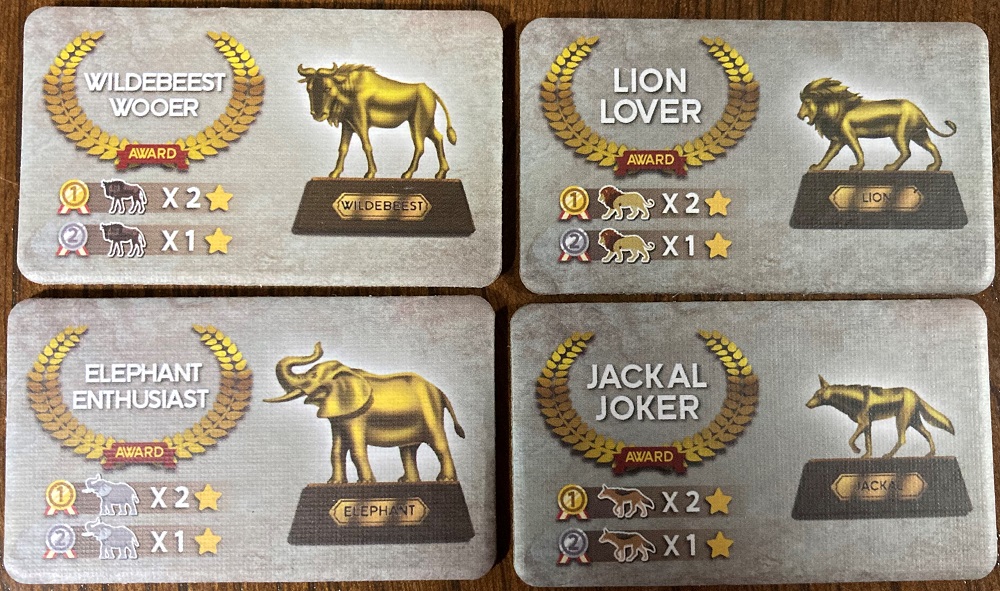
Award tiles are selected randomly at the start of the game and used during the preparation phases before the 4th and 6th rounds. Each tile shows one of the 12 animal types. Players with more animals of that type as well as animal icons on their completed scene cards can earn points.
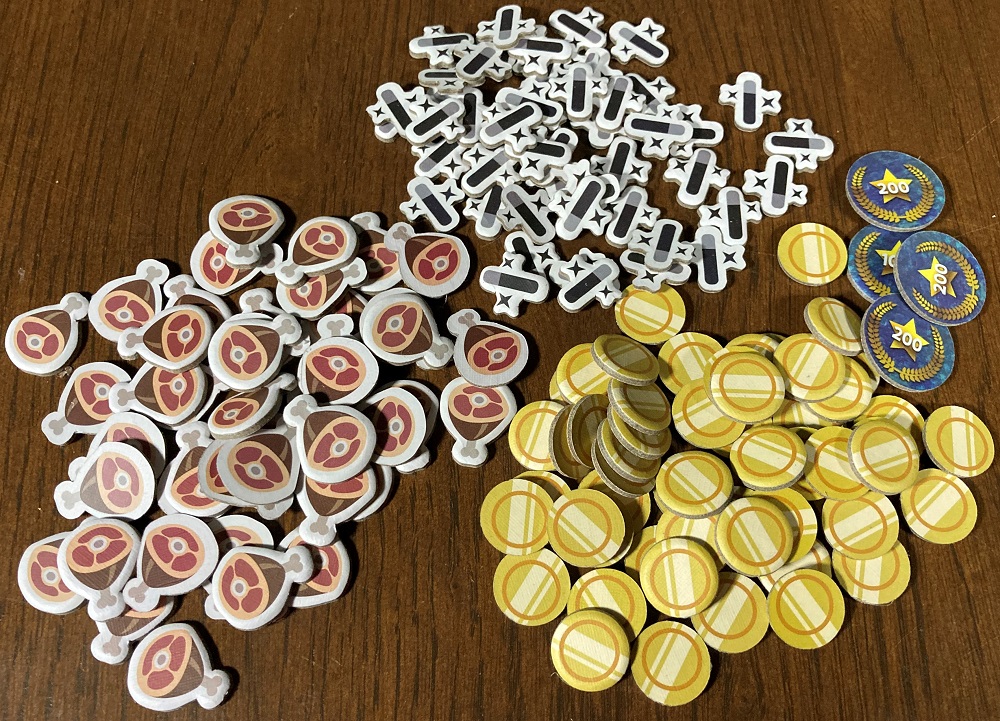
There are several types of tokens used during the game. Coin tokens are used to pay for actions. Food tokens can be spent to move animals already placed on the map as a free action. SFX tokens represent special effects and when spent can eliminate one terrain requirement for completing a scene card.

Each player has two player markers in their color. One is placed on the map in the score track to show the points that player has earned. The other marker is used to select basic actions on the action board.
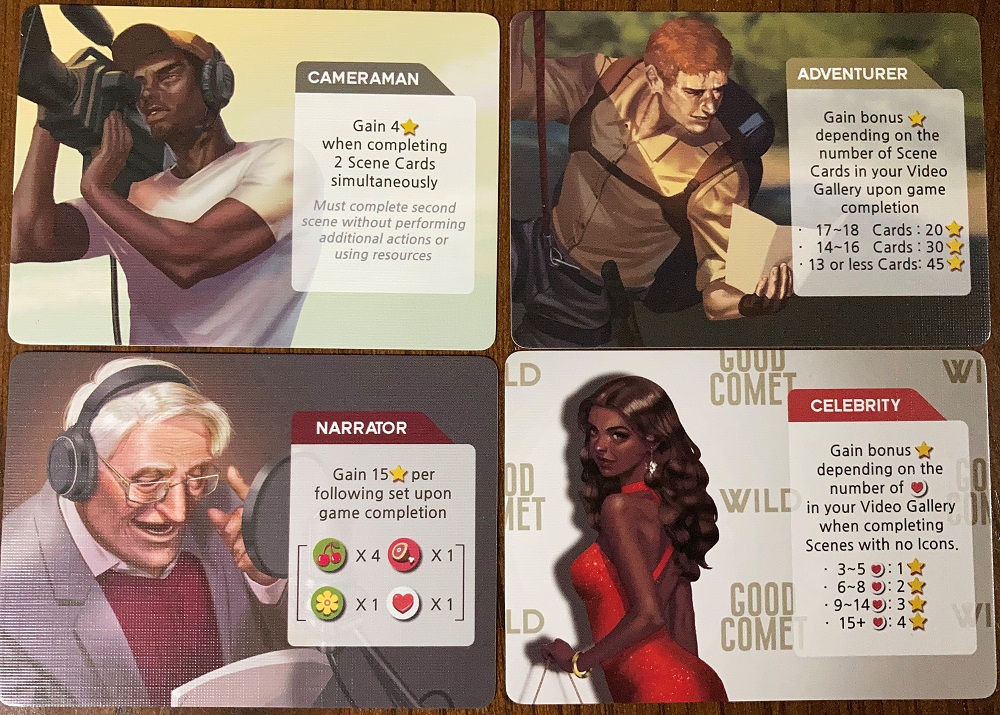
Specialist cards are part of the advanced rules. During setup, players draw three specialist cards. They keep one and discard the other two back to the box. These cards are placed in front of the player and have special abilities. Some give bonus points during the game while others provide points at the end of the game. Each specialist and their ability is unique.
How to Play WILD: Serengeti
The Goal
The goal of the game is to have the highest documentary score at the end of the game.
Setup
Start off by placing the map in the center of the table with the action board next to it. Place the 36 animals in their respective locations as shown on the action board. Position lock tokens on spaces with a 4P if playing with less then 4 players and on the 3P spaces as well if playing with fewer than 3 players. Shuffle all of the scene cards and place them in a face down deck near the map. Draw the top six scene cards and place them face up to create a scene card pool next to the deck. Leave a space for the discard pile as well.
Place the Rock of Ages at one end of the play area. Put the round marker on the first space to mark the round. Shuffle the awards tiles and select two. Then place them face up and place them on the Rock of Ages near the spaces for rounds 4 and 6. Return the remaining awards tiles to the box since they will not be used for the current game. Next shuffle the Great Migration deck and place it face down next to the Rock of Ages. Position the coin, food, SFX and score tokens in piles where all players can reach them.
Each player now selects a color and takes the two player markers and a video gallery bar that matches their color. Place one of the player markers for each player on or near the ‘0’ space on the point track that goes around the edge of the map. Players then each draw 8 scenes cards, selecting 4 to keep and 4 to discard to the discard pile. Give each player 6 coin tokens as their starting resources for round 1. The player who most recently watched a wildlife documentary goes first. Give them the first player marker. You are now ready to play WILD: Serengeti.

Gameplay
WILD: Serengeti is played in 6 rounds with a round preparation in-between each round. During a round, players take turns where they can either perform a basic action or pass. Once a player passes, they can no longer take any actions for the remainder of the round. Players who have 4 or more coins cannot pass. When all players but one have passed, the remaining player may take only one more turn before they must pass. Once all players have passed, the round is over and preparation for the next round begins.
Round Play
During a player’s turn, they can perform 1 basic action and as many free actions as they choose. Basic actions cost 1 coin. A player can also perform a second basic action in the same turn by paying an additional 2 coins. For free actions, players can discard incomplete scene cards. If they discard 2 or more scene cards at the same time, they can collect 1 coin. Players can also complete scene cards and spend food and SFX tokens as free actions.
There are 8 basic actions players may perform. To take a basic action, a player pays a coin to the pool and then places their player marker (not the one on the point track) on any empty space on the action board. They cannot place a marker on locked spaces or spaces occupied by the marker of another player. If a space is occupied, the player can pay an extra coin to place their marker next to the space and take that action.
The Discover Carnivorous Predators action lets a player take an crocodile, lion, or leopard from the action board and place it onto an empty space on the map. The Discover Large Mammals allows a player to place an elephant, rhino, or giraffe onto the map. Discover Scavengers has hyenas, jackals, and vultures for placement and Discover Migratory Herbivores offers Gazelles, Zebras, and Wildebeests for placement. Swap Animal Positions lets you select two animals already on the map and swap their locations. Move Animal 1-3 Spaces allows a player to move one animal up to three spaces on the map. They cannot move diagonally. While you can move an animal through a space with an animal, you cannot end a move in an occupied space. The Swap and Move Animal actions cannot be taken during the first round. Take 1 Card From Scene Pool lets a player take a scene card. They can pay one extra coin for each additional card they take. Replace the cards taken from the deck, but the current player cannot take from these new cards. Finally, a player can Redraft Scene Card Pool and Take 1 Card. Discard all six cards in the pool and draw six new ones. Then the player can select one. If they want more, they can pay a coin for each additional card. There is a limit of eight incomplete scene cards for a player, so if you ever end up with more than eight of these cards, you must discard your excess.
Completing a Scene

At any time during their turn, a player may choose to complete a scene. To do this, they must have the animals shown on one of their incomplete scene cards in the proper alignment and/or terrain. There are three types of scene cards. For a terrain scene, the animals shown must be in the terrain shown and can be anywhere on the map. For straight-line scenes, the animals must be in the same order as shown on the card on the map. They can be going up, down, left, or right and do not have to be adjacent. Some of these scene cards also have terrain requirements. For adjacency scene cards, the animals connected to the central animal must all be within one of the 8 spaces around the central animal. Some animals may have to be in specific terrain as well. Players can spend a food token to move an animal of their choice one space as a free move. They cannot move it diagonally. Multiple food tokens can be spend for moving an animal several spaces or even moving more then one animal. SFX tokens can be used to ignore one terrain requirement on a scene card. Spending these tokens are free actions which you can take during your turn. Also, a player can complete as many scene cards as they want during a turn since these are free actions.
Once a scene card is completed, it is placed beneath the player’s video gallery bar to create a tableau. The reward is collected immediately and can be points, resources, or a combination of the two. There are also icons at the top of many scene cards. These can provide additional points at the end of the game, increased rewards when completing scenes, or provide resources during the round preparation phase. Therefore, place your completed scenes so all of these icons are visible.
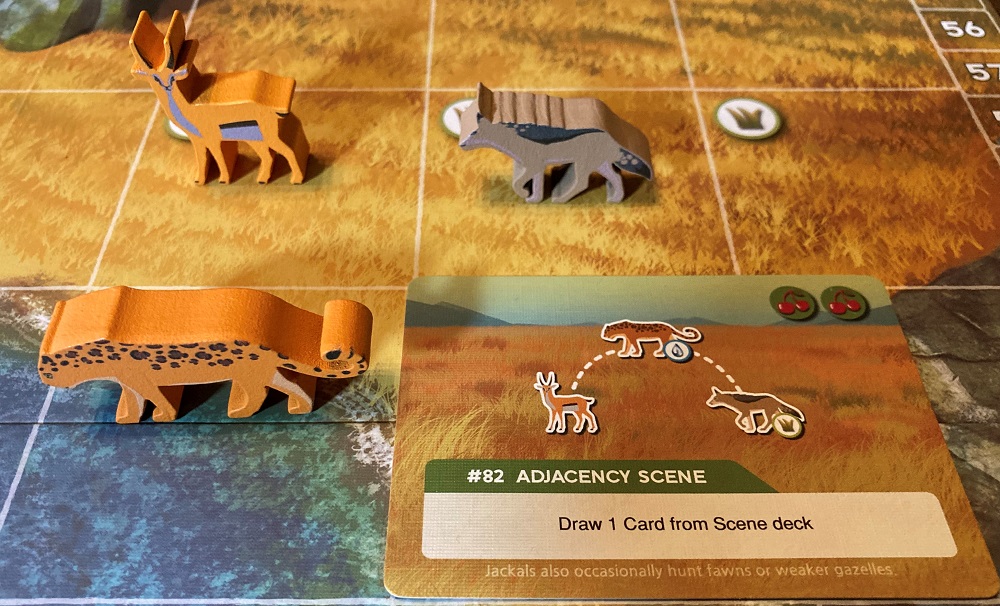
Round Preparation
After all players have passed, the round preparation phase begins. It consists of six steps. First move the round marker on the Rock of Ages to the next round space. There is no preparation before the first round. Setup includes this. Before rounds 4, 5, and 6, there are round events that are shown on the round spaces on the Rock of Ages. Before 4th and 6th rounds, there are Awards Ceremonies. For these, players look at the animal on the awards tile for that round. They then add up all of that type of animal they have shown on their completed scenes as well as the number of animal tokens on those cards. Whoever has the highest total earns double this number in points. The player in second place gets just the total number in points. In case of a tie, the players tied all receive the 1st or 2nd place reward. The Great Migration takes place before rounds 4, 5, and 6. For this, draw the top card from the Great Migration deck. It shows a diagram of the spaces on teh map. For 1-3 player games, remove all of the animals on spaces with a brown square on the card. If playing with 4 players, also remove animals on the spaces with blue squares. Place these removed animals back onto the action board in their designated spaces. After the round events are completed, discard all six cards in the scene card pool and draw six new ones. Each player then draws 4 scene cards and can keep one while discarding the other three. If they wish to keep more, they can pay one coin for each additional scene card they keep. Next players receive their round rewards. They get 6 coins for rounds 1-3 and then 7 coins for rounds 4-6. If their completed scene cards have food or SFX icons on them, then they also collect one token for each icon of that type. Finally, pass the first player marker to the player to the right and they start off the next round by going first.
Game End
The game ends after round 6. Players can additional points based on the number of Like icons on their completed scene cards. The player with the most points is the winner. In case of a tie, the player with the most completed scene cards wins.
Why You Should Play WILD: Serengeti
Let me start off by saying this game has incredible table presence. It looks amazing. The map and action board are colorful. The Rock of Ages offers a three-dimensional way to keep track of rounds and remind players of specifics for each round. The scene cards are colorful and easy to interpret. However, the best part of the presentation are the animals. These wooden figures are large and colorful with details printed on them. The prototype figures I was sent look great and I imagine the final produce will look just as good if not better.
There are a lot of games that look great, but lack great gameplay. WILD: Serengeti is not one of those games. Instead, the mechanics and gameplay make this an engaging and fun game play despite the cool components. During a round, as the players spend coins to take actions, they begin placing animals onto the map in order to complete the requirements on their scene cards. Since all scene cards are face up on the table, players can see each other’s scenes. Therefore, you can try to position animals so they help you but not your opponents. You can also position or move animals to prevent them from completing scenes. For the first couple rounds, players usually focus on completing simple scenes so they can get some cards into their tableau under their video gallery bar. Try to complete scene cards with food and SFX icons so you can receive those types of tokens during the round preparation phase. Those tokens can make more complex scenes much easier to complete by allowing you to move animals and disregard terrain requirements. During my first playthrough of the game, I did not realize how important this tableau of completed scene cards can be. I was more focused on earning instant rewards for completing scenes. However, as you collect a lot of different icons, these can increase the amount of rewards you collect for later completed scenes. Essentially you are building an engine to increase rewards and resources which in turn lead to more rewards and resources. Also be sure to collect as many heart shaped Like icons since they can really boost your score at the end. Three of them will get you 7 more points, 7 Likes will get you 24 points and 10 likes earns you a whopping 45 points. If you get more than 10 likes you get even more points starting over on the scale.
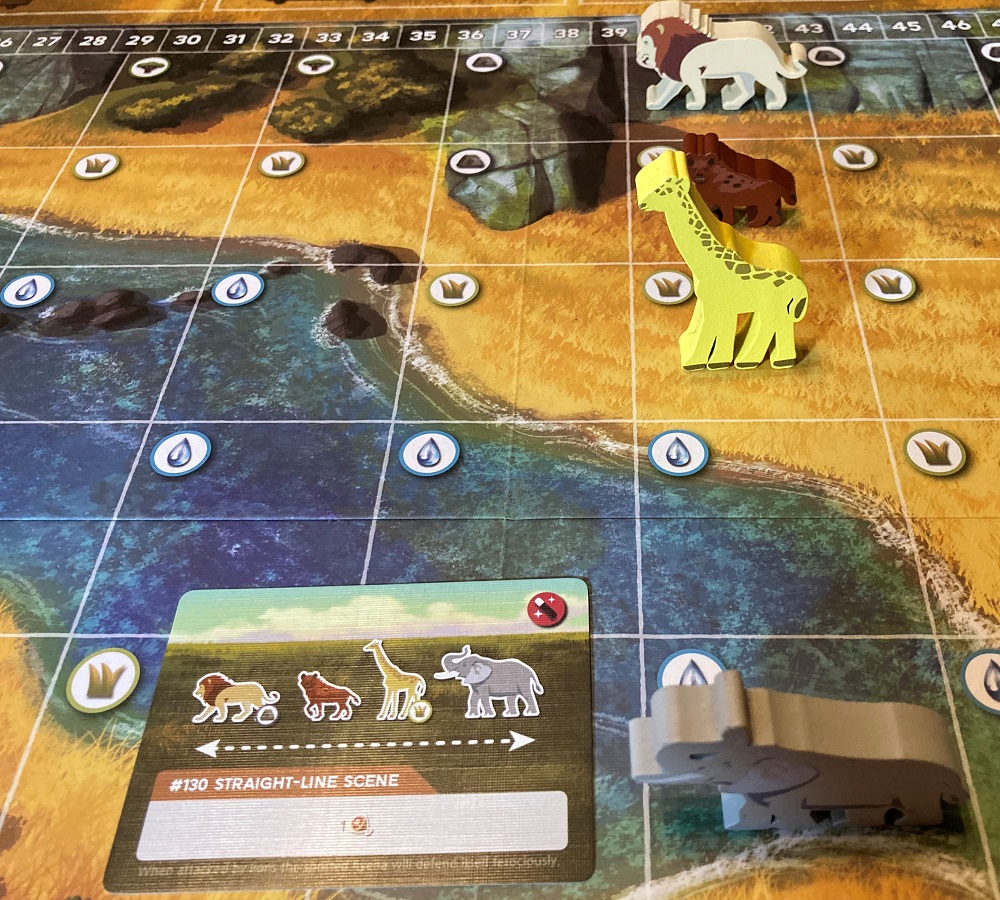
There is a lot of strategy that goes into playing WILD: Serengeti. It is always a good idea to pay attention to the types of animals on the award tokens since they can provide a lot of points to the player who come in first place. They are awarded before the 4th and 6th rounds, so try to collect and complete scenes with those animals as well as scene cards with animal icons at the top. At the same time, you need to build up your tableau and have a variety of incomplete scene cards on hand to take advantage of opportunities that arise as the other players place and move animals around. Beginning players sometimes forget about their free actions. You can complete a scene card at any time during your turn. For example, before you use your basic action, you could spend a food token to move an animal and then complete a scene. Then pay a coin for a basic action that may help you complete another scene. Also, don’t forget you can spend two more coins to take a second basic action during your turn. While this can be costly, at times it is worth it, especially if you are worried an opponent may move some of the animals in order to complete one of their scene cards and mess up your plans for your next turn. Finally, the Great Migration can ruin the best laid plans. Before the last three turns, between 9 and 14 spaces may be cleared of animals. So be sure to complete as many scenes as possible before the end of each round or you may be starting over the next round.
My family and I loved playing WILD: Serengeti. The beautiful and detailed components not only help attract players to the game, the animals also provide a tactile sensation as you move them around the map. Providing wildlife sounds as you do so is optional. Placing the animals in the correct spaces in order to complete scenes adds a puzzle solving aspect and exercises spatial thinking. You have to determine the order in which scene cards are completed because putting some into your tableau first will increase the value of others completed later. This requires some patience and planning ahead. Since there are limited spaces on the action board, a common feature in worker placement games, you may have to change your strategy in response to other players–or pay an extra coin to do an action without an opening. The fact that all of these diverse mechanics are found in one game and that they work so well together, makes WILD: Serengeti not only a game your family or game group will enjoy playing, they will want to play it again and again to try different strategies and get a different variety of scene cards to complete. You can even play it by yourself thanks to solo rules which are included where you try to score certain number of points within the six rounds. This is actually a bit tougher since you don’t have other players placing animals on the map which you can use to complete your scenes. For all of the reasons I have previously stated, I highly recommend WILD: Serengeti and encourage you to check out the Kickstarter campaign
For more information or to make a pledge, visit the WILD: Serengeti Kickstarter page!
Click here to see all our tabletop game reviews.
![]() To subscribe to GeekDad’s tabletop gaming coverage, please copy this link and add it to your RSS reader.
To subscribe to GeekDad’s tabletop gaming coverage, please copy this link and add it to your RSS reader.
Disclosure: This post was sponsored by Bad Comet Games.



